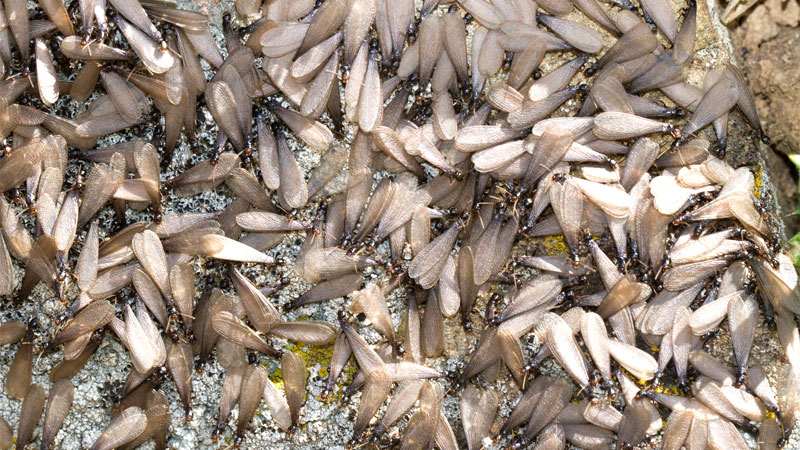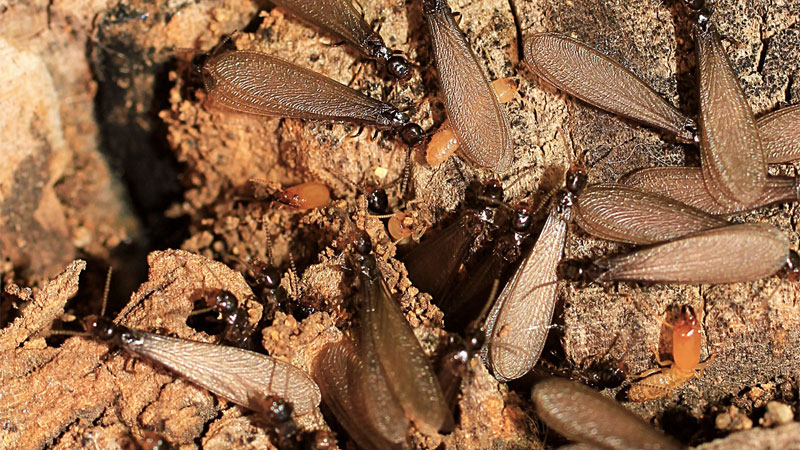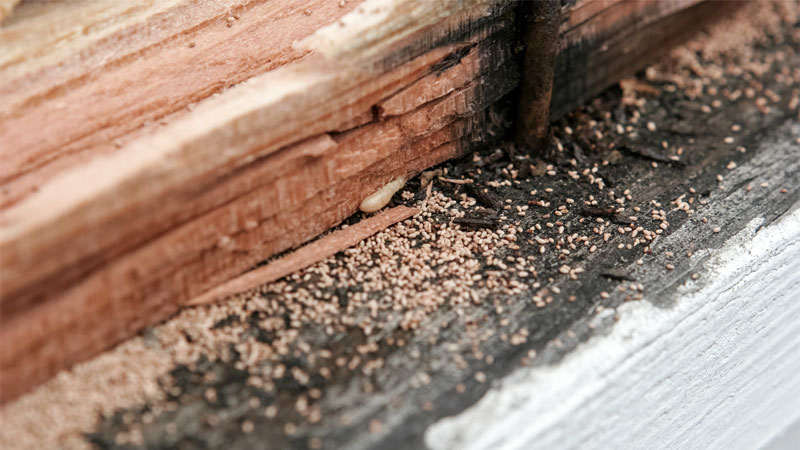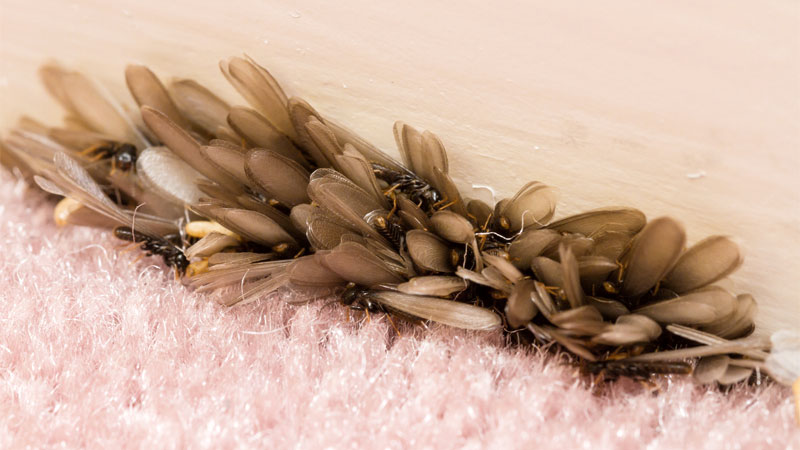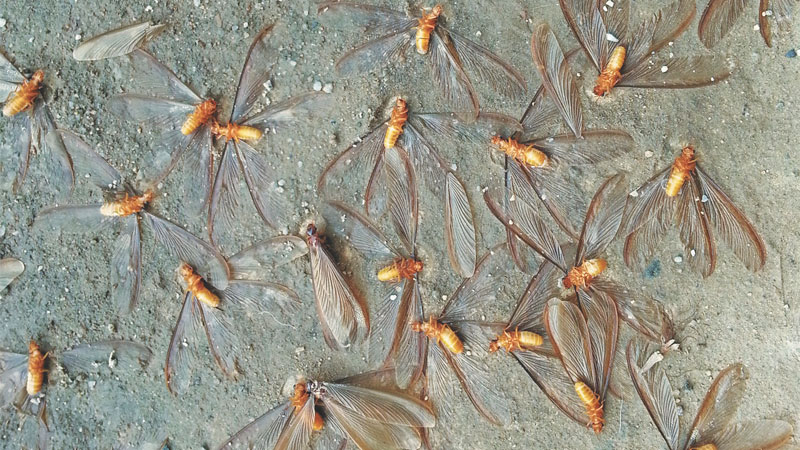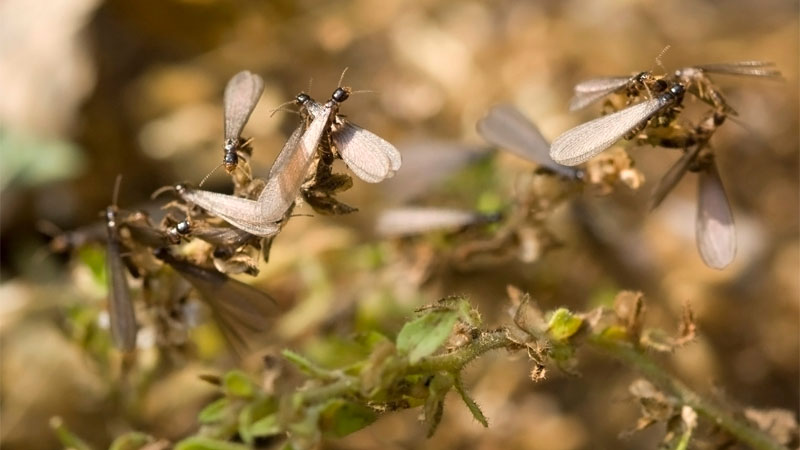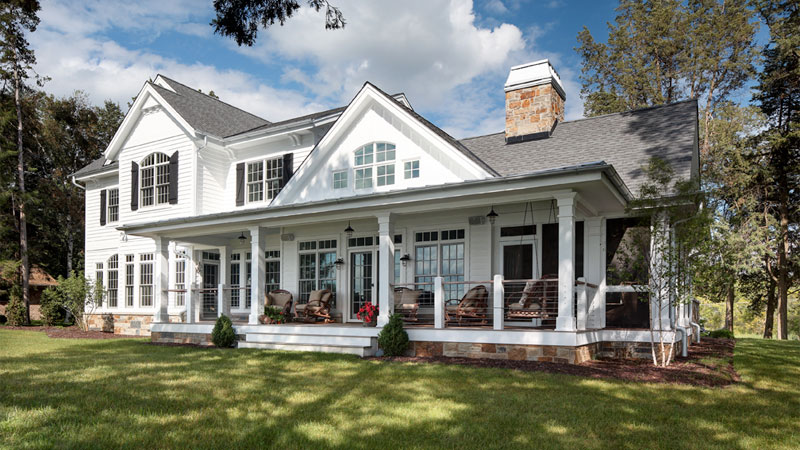They’re perhaps the single most dreaded home invader outside of bedbugs and cockroaches. In fact, the mere mention of termites can send homeowners into a panic due to this insect’s reputation for destruction.
Yet there’s a type of termite even scarier than the ones you normally dread – the winged termite.
Now, let’s get one thing straight. A winged termite actually just grew their wings for the mating flight. But there are a lot of differences between flying and non-flying termites that often cause people to think they’re two separate critters.
Let’s take a moment to look at these two variations to see where they differ. Then we’ll go over how to get rid of flying termites (and non-flying as well) and and how to make sure they won’t come back.
Getting to Know Flying Termites (Alates)
When it’s time for a termite colony to expand, many of the workers will grow wings and become alates. The workers may be both male and female, depending on the species.
What Do Flying Termites Look Like?
A termite alate looks almost identical to workers with the exception of two pairs of equal-length wings. These wings rest parallel to the body when not in flight but are kept at a 90 degree angle wile flying.
Another easy identifier is that a winged termite is about as graceful as a tree thrown from a cliff.
See Also: 9 Bugs That Resemble Termites
When Do Winged Termites Appear and How Long Do Swarms Last?
There’s a lot of variation from one species to another, with some species taking flight in summer and others in winter. They’re more commonly seen during the day but will also appear at dusk in areas that are brightly lit.
The termite swarmers tend to only remain in flight for 30 to 40 minutes. Only the largest species are capable of flying far from their original nest.
What Are Flying Termites Attracted To?
During their mating flight, alates are attracted to light sources. Usually, the swarmers will appear during the day, but may also occur in the evening if the area is brightly illuminated.
Alates also have a different mating behavior than ants or bees. The male and female alates will pair off and search for a place to start their nest. This includes rotting or soaked wood as well as mulch piles.
Once they’ve found a suitable location, they’ll dig a burrow big enough for the two of them, seal themselves inside, then finally mate.
Do Flying Termites Eat Wood?
With the exception of excavating the initial burrow, alates won’t chew or even show interest in wood throughout the mating flight.
Do Flying Termites Bite People?
Flying termites won’t bite humans or pets and tend to devote all of their energy to mating.
Are Flying Termites Dangerous?
Generally speaking, winged termites aren’t dangerous. However, their presence suggests there’s a well-established colony nearby. There’s also the risk that they’ll start their own colonies in your home or shed.
Flying Termite vs Flying Ant
Just as there are some telltale differences between ants and termites, the two have some obvious differences when mating. Ants are decent fliers, although they won’t win any awards for their skill.
Their wings are different sizes and are held at an angle in flight. They also have a habit of mating while in flight.
Meanwhile, termites are absolutely horrid fliers and have very little direction sense once airborne. This is why they’re known as swarmers, since they’ll bumble about in the air until they find a potential nesting spot.
Their wings are of equal size and stick straight out from the body. Finally, they pair up while in flight , but won’t mate until they’ve created the initial burrow.
Getting to Know Termites
Termites are often confused with ants, although they look and behave differently. Here’s what you need to know about wingless termites.
There are currently around 3,000 recognized species of termite, 50 of which are native to the US. These pests are broken down into three groups, based on their preferred shelter: drywood termites, dampwood termites, and subterranean termites.
Most species originally lived in the ground or trees, but around 83 species worldwide are now known to build their nests (called termitaries or termitariums) in human structures with a total of 183 species being known to harm structures and/or crop
What Do Termites Look Like?
Termites have a basic shape that often gets them lumped in with ants, especially in terms of head shape. However, they’re actually related to cockroaches.
They generally range in size from 3/16 to 9/16 inches, although the queens are much larger, with the largest species having a queen measuring four inches long.
The eggs hatch into nymphs (with unfertilized eggs becoming males) which resemble tiny versions of the adult workers. The nymphs go through three molting stages. All nymphs become workers, regardless of their sex. However, some workers will later become either soldiers or alates.
Ranging from whitish to brown, the soldiers and workers of most species lack eyes, while alates have compound eyes. The heads of soldiers are much larger and often a darker shade than the rest of their body.
Their mandibles are designed in such a way that they require workers to feed them, but the payoff is that they can use those heads to block passageways when the colony is being invaded.
Do Termites Eat Wood?
Termites actually feed off of cellulose, which is like a glue that holds wood fibers together (and sometimes used to prevent caking in grated parmesan cheese). However, the amount of damage to the wood as the termites feed on the cellulose varies from one species to another.
Most species that damage homes are dampwood or drywood termites, which can target wooden structures or wood-based debris. Underground termites can still be a threat, but are less likely to invade your home.
What Are Termites Attracted To?
As a general rule, termites look for wood, moisture, and darkness. Those species known as dampwood termites have their name because they seek out damp wood. Conversely, drywood termites prefer older dry wood.
Despite most termites being blind, they will still try to remain hidden from view due to the sheer number of natural predators they face.
Another common attraction for termites is warmth. This is especially true of drywood species, which tend to prefer warm areas such as Florida or Texas, but are often unknowingly transported further north in crates and other wood products.
Once they find themselves in a cold region, they usually gravitate towards human structures for warmth.
Do Termites Bite?
Only the soldiers have been known to bite, but this is very rare and doesn’t cause any pain or side effects.
Are Termites Dangerous?
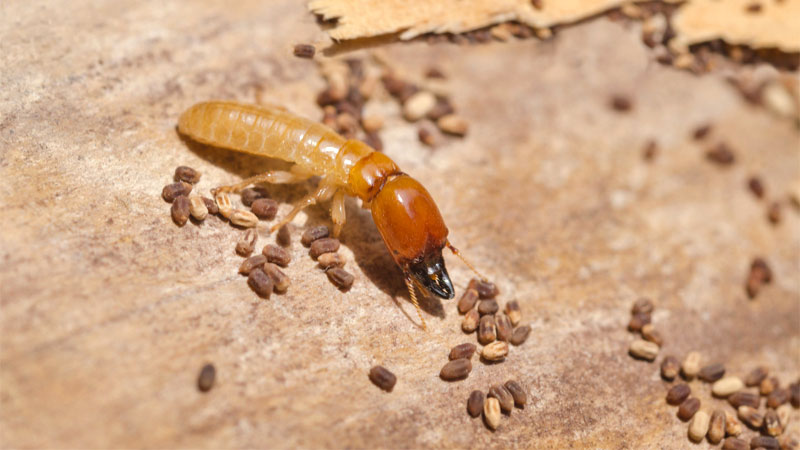
Termites prefer to stay hidden, often cutting their tunnels and galleries just under the surface of infested wood. This leads to severe structural damage, as well as massive agricultural damage to fruit trees and ornamental plants.
There are 18 subterranean species of termite in the US known to cause property damage. Interestingly enough, less than 10 percent of drywood species cause damage, yet are responsible for a large percentage of all termite damage.
Termites can also pose a health risk to humans. Termite droppings can look a bit like sesame seeds and may cause skin reactions. Their tunneling activities can also lead to mold. This in turn can lead to respiratory issues or trigger asthma.
Finally, they’re known to chew through wires, creating a risk of shock or electrocution.
Termite vs Ant
Ants will leave their nest to find food while termites burrow into wood to eat the cellulose.
Ant colonies (with some notable exceptions, such as carpenter ants and Argentine ants) have only one queen and form small mounds while termites can have several secondary queens and sometimes build huge pillars when nesting in the ground.
If you manage to catch one, there are three easy identifiers.
- Ants have bent antennae, while termites have straight antennae.
- Ants have a visible pinched area between the thorax and abdomen compared to the almost indistinguishable separation point on termites.
- Ants have compound eyes while worker or soldier termites won’t have eyes.
Wingless termites and ants can’t be distinguished by color, contrary to popular belief.
Signs of a Flying Termite Infestation
Spotting termites in their mating flight can be a warning sign of an infestation, but it not necessarily proof of one.
The exception is when you find alates swarming inside your home or discover discarded termite wings on windowsills or other brightly lit spots. This indicates there’s an active infestation in your home.
Other signs of termite activity include:
- Blistering of wooden floors or painted wooden surfaces similar to water damage
- Hollowed out wood
- Thin mud tubes about the width of a pencil (these protect subterranean termites from predators and the elements)
- Sawdust or tiny pellets the size of coffee grounds made of wood (frass)
- Tiny holes in wooden surfaces
- Tiny rattling noises coming from the walls (this is actually the termites tapping their heads to communicate with one another)
- Termite mounds
- Multiple alates crawling around the bathroom or kitchen, in windowsills, or flying around lights
Getting Rid of Flying Termites
Now that we’ve had a look at termites in both their winged and wingless forms, it’s time to evict them and make sure they don’t come back.
- Use Only with Whitmire Micro-Greens or BASF Approved actuator.
- Power Source Type: Manual
From the House
Unfortunately, the only truly effective way to get rid of an indoor termite colony is to hire a professional termite exterminator, which can be quite expensive. However, there are a few things you can to to reduce the size of the infestation.
Termite Killers and Bait Traps
These are a simple remedy and tend to work really well. Companies such as Spectracide, BioAdvanced, BASF, and others offer termite killer sprays, granules, powders, stakes, and bait traps that will poison any termites which consume it.
They then take that poison back to the colony and share it with their nestmates. Some of our favorites include:
- TERMITE KILLER: Easy to use granuals kills the termites you see, and the ones...
- PERIMETER DEFENSE: Treat around the perimeter of your home, garage, wood piles...
- EASY APPLICATION: Just sprinkle, water, and walk away
Homemade Traps
Alternatively, you can dampen some strips of cardboard and lay them where termites have been seen. The termites will begin harvesting the cellulose from the cardboard, allowing you to get them with an insecticide spray.
Other options include either boric acid or diatomaceous earth, which work the same way. Simply sprinkle them where termites have been seen and they’ll cause any termite walking over them to dehydrate and die.
While not necessarily toxic to children or pets, it’s best to keep these remedies out of their reach.
Orange oil is a deadly foe of drywood termite species and is often used by professionals. Simply pour the oil into termite holes or make a spray with water (and vinegar, if you wish) to treat furniture and other wood surfaces.
From the Yard and Garden
While you don’t want termites in your home, the damage they can do to your garden or landscaping (plus the risk of them migrating indoors) is often a good reason to get rid of outdoor colonies.
While you can use companion planting to protect parts of the garden, the following two methods will get much broader results.
Read Also: Will Gasoline Kill Termites?
Employ Natural Predators
Termites are a very common insect, which means they tend to have a lot of natural enemies. Try inviting these predators into your garden or yard as a means to naturally control termite populations. Some of the critters that feed on termites include:
Ants
Despite their similarities, ants are partial insectivores, meaning they’ll eat other insects including termites. Now, ants are still capable of doing some damage if they infest your home, but in the garden they can often be quite beneficial.
Since ants and termites are natural enemies, the two will often keep each others’ populations down. Even better, ants will often actively invade termitaries with little prompting.
Birds
A wide range of birds actively feed on termites. These include:
Flies
While not exactly something you’d want to encourage, there are several species that will feed off of termites. You can actually breed these flies and release them outdoors, although they can become rather annoying when in flight or swarming your own food.
Humans
The US is one of only a handful of nations or cultures that doesn’t include insects as part of their regular diet. In fact, termites are a popular snack and source of protein in many countries, especially in Africa and among the Aboriginal nations of North and South America.
They’ve even been considered for the space program, as they’re easy to breed, full of protein, and can be used to recycle waste products.
Mammals
A lot of smaller mammals will feed on termites. Having them invade your yard or home can actually be a sign that you have a termite infestation. Some mammalian predators are:
- Armadillos
- Bats
- Moles
- Shrews
- Skunks
Reptiles and Amphibians
These critters absolutely love insects, and termites are no exception. Frogs, geckos and other lizards, toads, and even snakes can turn a termite infestation into a feast.
Spiders
While you don’t want to attract a black widow or brown recluse onto your properly, spiders can be staunch allies against unwanted insect pests. Some, such a the trapdoor spider or wolf spider, are natural hunters that can whittle away at a termite population without posing a significant threat to humans or pets.
Other Natural Predators
There are some other predators that don’t fall into the other categories, such as assassin bugs, beetles (especially ladybugs, AKA lady beetles), nematodes, parasitic wasps, and roundworms.
Termite Prevention
Important: While you may have heard that naphthalene balls repel termites, we highly discourage their use as their hazardous nature is simply not worth it.
#1 – Exclusion Techniques
Preventing termites involves mostly the standard measures of exclusion and cleanliness. Seal off any potential entry points to your home and check wood regularly for signs of damage. Address any leaks or standing water on the property. Keep wood piles away from the house and avoid using untreated wood for projects.
#2 – Trenching
You can also employ trenching, which involves applying a termiticide along the perimeter of your home. This is known as trenching because you have to actually dig a trench before applying the termiticide since termites are natural burrowers.
However, once applied, the termiticide acts similarly to bait poisons and can last for up to five years.
#3 – Minimize External Lights
Avoid leaving a lot of external lights on in the evening to discourage late-day swarms. You will also want to ensure all open windows or doors have proper screens.
#4 – Keep a Buffer Around Your Home
Finally, keep a dead zone between your home and the nearest plants, usually six inches or greater. This includes keeping your yard clear of debris.
#5 – Avoid Wood Mulch
Use a substitute for standard mulch. Rubber mulch is one popular alternative, as is river rock and pea gravel. However, if you insist on using wood mulch, aim for cedar mulch, as the resin produces a smell and texture that termites and many other critters hate.
- How to Get Rid of Hawks - March 8, 2024
- How to Get Rid of Pill Bugs (Rolly Pollies) - March 1, 2024
- How to Get Rid of Groundhogs (Woodchucks) - February 5, 2024

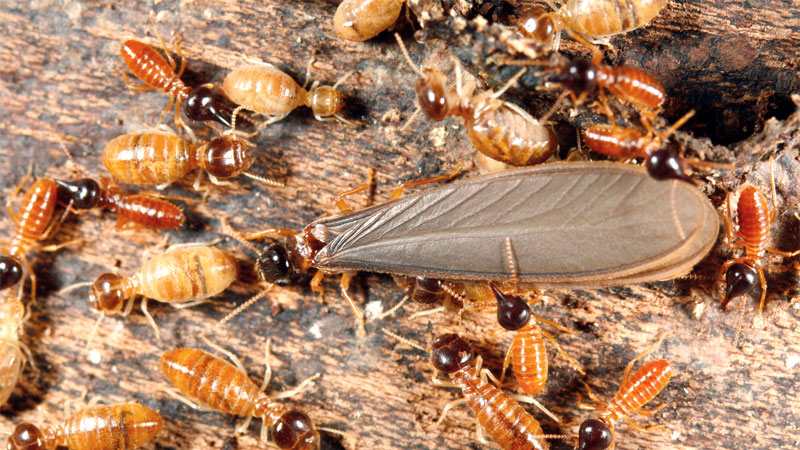
 Just tell me how to get rid of ’em.
Just tell me how to get rid of ’em.
